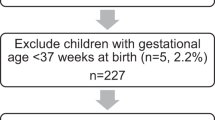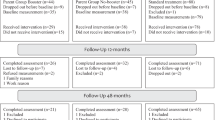Abstract
Objective:
To examine the long-term effects of having one overweight or obese parent on child weight status and determine whether these effects vary according to parent sex.
Design:
Prospective study: Longitudinal Study of Australian Children (LSAC).
Subjects:
Two-parent families (N=3285) from the LSAC were included if height and weight data were available for both parents and their child at the 2004 and 2008 time points.
Measurements:
Child weight status category (healthy, overweight, obese) in 2008 when the child was aged 8–9 years. Regression modelling was used to investigate how self-reported parent weight status in 2004 influenced measured child weight status 4 years later.
Results:
Parent body mass index (BMI) was significantly correlated with child BMI, but there was no evidence of sex-specific associations between parent and child BMI correlations. The results from the regression analysis showed that having an overweight or obese father, but a healthy weight mother, significantly increased the odds of child obesity (odds ratio: 4.18, 95% confidence interval (CI): 1.01–17.33 and odds ratio: 14.88, 95% CI: 2.61–84.77, respectively), but the reverse scenario (overweight or obese mother with a healthy weight father) was not a significant predictor of child overweight or obesity (odds ratio: 2.52, 95% CI: 0.38–16.71 and odds ratio: 2.56, 95% CI: 0.31–21.26, respectively).
Conclusions:
Children with overweight or obese fathers are at a higher risk of becoming obese. This suggests that interventions are urgently required to test the efficacy of treating overweight fathers as a key strategy for childhood obesity prevention and/or treatment.
This is a preview of subscription content, access via your institution
Access options
Subscribe to this journal
Receive 12 print issues and online access
$259.00 per year
only $21.58 per issue
Buy this article
- Purchase on Springer Link
- Instant access to full article PDF
Prices may be subject to local taxes which are calculated during checkout
Similar content being viewed by others
References
Lobstein T, Baur L, Uauy R . Obesity in children and young people: a crisis in public health. Obes Rev 2004; 5 (Suppl 1): 4–85.
Olds TS, Tomkinson GR, Ferrar KE, Maher CA . Trends in the prevalence of childhood overweight and obesity in Australia between 1985 and 2008. Int J Obes 2010; 34: 57–66.
Lean MEJ . Childhood obesity: time to shrink a parent (editorial). Int J Obes 2010; 34: 1–3.
Burke V, Beilin LJ, Simmer K, Oddy WH, Blake KV, Doherty D et al. Predictors of body mass index and associations with cardiovascular risk factors in Australian children: A prospective cohort study. Int J Obes 2005; 29: 15–23.
Semmler C, Ashcroft J, van Jaarsveld CHM, Carnell S, Wardle J . Development of overweight in children in relation to parental weight and socioeconomic status. Obesity 2009; 17: 814–820.
Whitaker RC, Wright JA, Pepe MS, Seidel KD, Dietz WH . Predicting obesity in young adulthood from childhood and parental obesity. New Engl J Med 1997; 337: 869–873.
Perez-Pastor EM, Metcalf BS, Hosking J, Jeffery AN, Voss LD, Wilkin TJ . Assortative weight gain in mother-daughter and father-son pairs: an emerging source of childhood obesity. Longitudinal study of trios (EarlyBird 43). Int J Obes 2009; 33: 727–735.
Leary S, Smith GD, Ness A . No evidence of large differences in mother–daughter and father–son body mass index concordance in a large UK birth cohort. Int J Obes 2010; 34: 1191–1192.
McLean N, Griffin S, Toney K, Hardeman W . Family involvement in weight control, weight maintenance and weight-loss interventions: a systematic review of randomised trials. Int J Obes 2003; 27: 987–1005.
Sanson A, Nicholoson J, Ungerer J, Zubrick S, Wilson K, Ainley J et al. Introducing the Longitudinal Study of Australian Children. The Australian Institute of Family Studies: Melbourne, Australia, 2002.
Soloff C, Lawrence D, Johnstone R . LSAC Technical Paper No. 1: Sample Design. Australian Institute of Family Studies: Melbourne, Australia, 2005.
Cole TJ, Bellizzi MC, Flegal KM, Dietz WH . Establishing a standard definition for child overweight and obesity worldwide: international survey. BMJ 2000; 320: 1240–1243.
Kuczmarski MF, Kuczmarski RJ, Najjar M . Effects of age on validity of self-reported height, weight, and body mass index: findings from the Third National Health and Nutrition Examination Survey, 1988–1994. J Am Diet Assoc 2001; 101: 28–34.
Wake M, Nicholson JM, Hardy P, Smith K . Preschooler obesity and parenting styles of mothers and fathers: Australian National Population Study. Pediatrics 2007; 120: 1520–1527.
Australian Bureau of Statistics (ABS). Socio-Economic Indexes for Areas (SEIFA), vol. 1.1. ABS: Canberra, Australia, 2001.
Australian Bureau of Statistics (ABS). National Health Survey: Summary of Results. ABS: Canberra, Australia, 2006.
Australian Bureau of Statistics (ABS). National Health Survey: Summary of Results. ABS: Canberra, Australia, 2009.
Danielzik S, Langnäse K, Mast M, Spethmann C, Müller MJ . Impact of parental BMI on the manifestation of overweight 5–7 year old children. Eur J Nutr 2002; 41: 132–138.
Flood V, Webb K, Lazarus R, Pang G . Use of self-report to monitor overweight and obesity in populations: some issues for consideration. Aus NZ J Public Health 2000; 24: 96–99.
Morgan PJ, Lubans DR, Callister R, Okely AD, Burrows TL, Fletcher R et al. The ‘Healthy Dads, Healthy Kids’ randomized controlled trial: efficacy of a healthy lifestyle program for overweight fathers and their children. Int J Obes 2011; 35: 436–447.
Rhee K . Childhood overweight and the relationship between parent behaviors parenting style, and family functioning. Ann Am Acad Political Soc Sci 2008; 615: 12–37.
Acknowledgements
This study was supported by a Strategic Initiatives research grant funded by the Faculty of Health, The University of Newcastle. This paper used data from the Longitudinal Study of Australian Children. The study was conducted in partnership between the Department of Families, Housing, Community Services and Indigenous Affairs (FaHCSIA), the Australian Institute of Family Studies (AIFS) and the Australian Bureau of Statistics (ABS). The findings reported in this paper are those of the authors and should not be attributed to FaHCSIA, AIFS or the ABS.
Author information
Authors and Affiliations
Corresponding author
Ethics declarations
Competing interests
The authors declare no conflict of interest.
Rights and permissions
About this article
Cite this article
Freeman, E., Fletcher, R., Collins, C. et al. Preventing and treating childhood obesity: time to target fathers. Int J Obes 36, 12–15 (2012). https://doi.org/10.1038/ijo.2011.198
Received:
Revised:
Accepted:
Published:
Issue Date:
DOI: https://doi.org/10.1038/ijo.2011.198
Keywords
This article is cited by
-
Effects of a family-based lifestyle intervention on co-physical activity and other health-related outcomes of fathers and their children: the ‘Run Daddy Run’ intervention
BMC Public Health (2023)
-
A Hybrid Mobile Phone Feasibility Study Focusing on Latino Mothers, Fathers, and Grandmothers to Prevent Obesity in Preschoolers
Maternal and Child Health Journal (2023)
-
Stakeholder engagement in developing a father-inclusive early life obesity prevention intervention: First Heroes
BMC Pregnancy and Childbirth (2022)
-
Influence of parental weight change on the incidence of overweight and obesity in offspring
BMC Pediatrics (2022)
-
Inequality in health opportunities in Indonesia: long-term influence of early-life circumstances on health
BMC Public Health (2022)



